Testimonials Home Page
Testimonials
“Justin has proven his worth by being more than an investment advisor. He tries to bring value to every interaction and is a name to watch in this industry going forward.” - Fabiana Lara, creator of The Next Big Rush
"Justin Hayek has been my investment advisor for over 7 years. I find his market knowledge invaluable. He has helped my portfolio grow, exceeding my expectations. I will continue to take advantage of his expertise and would highly recommend him to anyone looking for a fantastic advisor!" - Chase Shymkiw, Maple Ridge, BC
A Quarterback, a Problem Solver, a Data Nerd: How Three Scrappy Uranium Geos Discovered the Most Valuable Rock on the Planet
By Justin Hayek
In January 2023 when Craig Parry, former CEO of IsoEnergy walked to the podium to receive the Colin Spence Award from the Association for Mineral Exploration (AME), he had every right to feel proud of the three co-recipient geologists walking to the stage with him.
Under Parry’s direction, Steve Blower, Andy Carmichael, and Justin Rodko explored an unloved, abandoned section of the famed Athabasca Basin, and discovered The Hurricane Uranium Deposit which turned out to be the most valuable rock on the planet.
One cubic metre of Hurricane’s high-grade domain weighs over 4.5 tonnes and contains 5,200 lb. of U3O8, worth almost half a million dollars at the current uranium spot price of USD $95/lb.
You’ve probably never heard of Blower, Carmichael or Rodko. They do not seek the limelight. They are usually out in the field, running drill programs, logging core, or buried in spreadsheets.
In my numerous individual and group conversations with these three geologists, they have consistently deflected praise and downplayed personal credit, showing little interest in their reputational legacy.
But the trio’s accomplishments are significant. The ISO team “has creatively tested new geological concepts in areas long considered to be adequately tested,” confirms the AME.
As an investment advisor at PI Financial, and private investor, I track the methods and success rates of geological teams. After the discovery of the Hurricane Deposit in 2018, the IsoEnergy share price rose 1,800% to its all time high in 2021.
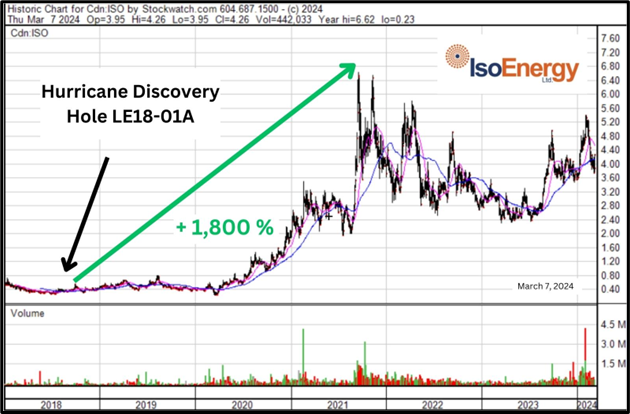
Blower, Carmichael and Rodko have left IsoEnergy and are now working together on a new uranium project in the Athabasca basin. More about that later. Right now, let’s meet these humble innovative geos, and learn how they operate as a team.
Steve Blower (The Quarterback)
 At the AME conference, Craig Parry told other attendees that Steve Blower was “The Tom Brady of The Athabasca Basin.” Brady was a legendary NFL quarterback, known for his accuracy and consistency. He was put on the field to score big touchdowns.
At the AME conference, Craig Parry told other attendees that Steve Blower was “The Tom Brady of The Athabasca Basin.” Brady was a legendary NFL quarterback, known for his accuracy and consistency. He was put on the field to score big touchdowns.
Steve Blower is put in the field to make big discoveries. Over the last 15 years, Blower has demonstrated an uncanny knack for finding uranium. [LinkedIn Profile].
“I’ve been exploring for uranium in the Athabasca Basin since 2006,” stated Blower. “Nuclear energy is critical for the decarbonisation of the energy sector. It’s easy for me to be passionate about it.”
“At IsoEnergy, Craig Parry was the boss, I was the VP of Exploration, Andy Carmichael and Justin Rodko were working with me. The hierarchy was not stratified. Andy’s a problem solver, and one of the best uranium exploration geologists I know. Justin is a self described ‘data nerd’ – but he’s also a terrific uranium exploration geologist. I trusted these two men, ideas flowed freely.”
“The Hurricane deposit area was previously explored by Cameco. With a $17 billion market cap, Cameco has different corporate goals than a $50 million uranium explorer. Larocque East, which contained the Hurricane Deposit, was low on their priority list. They did a couple of passes, didn’t hit much, and moved on. With the uranium pipeline they’ve got, that was a sound corporate decision. But it leaves opportunities for smaller operators, who are focused, patient and nimble enough to try new ideas.”
“I worked at Denison mines for four years with Steve Blower and followed him to IsoEnergy,” stated Carmichael. “Steve is a tremendous geologist, and a great mentor. Working with Steve, you are allowed to make mistakes without fear of punishment. That encourages innovation. As VP of Exploration, he listens carefully to the people in the field, the people on the ground.”
“When IsoEnergy purchased Hurricane, the historical hole we ultimately followed up on, had been sitting there for about 13 years,” recalled Rodko. “In a time when most uranium companies were just trying to survive, Craig Parry and Steve Blower put together the winning bid. Craig trusted Steve’s judgement that it was a property worth exploring. Steve trusted Andy, and Andy trusted me.”
“Steve is a born explorer,” concluded Rodko. “He pushes the idea that you can explore overlooked areas, trying new ideas.”
Andy Carmichael (The Problem Solver)
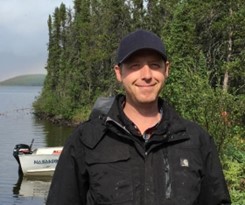
Andy Carmichael has spent the last 18 years exploring for uranium in the Athabasca Basin, Hornby Bay Basin, Colorado Plateau, and Namibia. After the discovery of the Hurricane Deposit, he served as VP of Exploration at IsoEnergy.
“From my perspective, exploration is largely problem solving,” stated Carmichael. “You are trying to assemble a 500-piece jigsaw puzzle -when you only have three pieces. It’s impossible to drill every square metre of a 160,000-hectare project. You are always extrapolating from limited information, limited data. The field work is typically remote, you won’t have everything you need. Things break down, they need to be fixed, you are forced to improvise.”
“Patience is also required,” added Carmichael. “After IsoEnergy picked up the Laroque East project, we did a lot of compilation and interpretation. We looked at every piece of available historical core. It was in terrible shape, infested with bats, but we learned a lot.”
“We realised that nearly every drill hole had intersected graphitic basement. There were two logical conclusions: 1. the historical operators had the world’s best geophysicist – with nearly a 100% hit rate on the geophysical targets, or 2. there was a broad conductive package in the basement. We decided to go with conclusion number two because it meant there was a lot of room left to explore.”
“One of the holes on the west side of the project was a dead ringer for an overshoot of an unconformity hosted deposit. Good looking alteration, with lots of broken sandstone. We decided to blitz that hole. Just move back 40 meters and drill a parallel hole, aiming directly underneath the best part of the alteration and structure.”
“That was our discovery hole. We hit the bullseye - the absolute center of the deposit,” continued Carmichael. “Hole LE18-01A”. The “A” is because the first hole hit a boulder and kicked off. We backed it out and drilled another one. After The Hurricane Discovery, we spent 2019 and 2020 delineating the deposit. By 2020 we found the ultra high-grade core. It was a world class deposit, even by the high standards of the Athabasca Basin.”
“I've known Andy a long time,” stated Blower. “He is one of the best uranium exploration geologists I know. Not only because of his technical skill, but his ability to get stuff done in the field.”
“When Andy brought me into IsoEnergy,” Rodko recalled. “It was a typical shoestring junior company. We had two drills turning, each doing about 200 meters a day, just scrambling. Broken drill bits, weather, machinery, water lines. To Andy, it’s just a series of fixable problems.”
Justin Rodko (The Data Nerd)

Justin Rodko is a Professional Geoscientist with nearly a decade of uranium exploration experience in Saskatchewan and Nunavut. When IsoEnergy drilled Hurricane Discovery Hole LE18-01A, he was 27 years old.
“I’m a prairie kid from Regina,” stated Rodko. “When I started at the University of Regina, I didn’t know they had a geology department. I was studying chemistry. I knew that wasn’t right for me. I switched to geology and never looked back.”
“Searching for uranium, you generally start with an electromagnetic (EM) survey, where you're looking for conductors, which may represent structures that drive fluid interaction between the basement and the sandstone. That's what precipitates uranium mineralization.”
“Hurricane was a mature project that we acquired from Cameco in 2018. There were about 18 holes drilled on the property. The first thing that we did was get into the data. If you're willing to spend hundreds of hours sifting through archival records, you’ll always find hints, clues, things others have missed.”
“We spent a long time digging through dilapidated core boxes, from the 1990s and early 2000s. The boxes are made of wood. They're out in the elements. Some of them are falling apart. They're infested with ants. But it’s important work.”
“The Athabasca sandstone is over a billion years old. It typically has a purple hue. When you're in an alteration system, it becomes more bleached. The closer you get to a major deposit like Cigar Lake, the whiter it gets.”
“By the third day of drilling, we start to see this bleached alteration. One of the things that's interesting about uranium mineralization: it's got a distinct smell. Geologists debate the cause of the smell. It’s unique. A bit like sulfur. If you’ve smelt it, you know it, you remember it, and you’ll always be able to identify it.”
“As the helicopter pilot lowered the core, the blades created a wash – a downward push of air into the core shack. Having worked at NexGen’s Arrow Deposit, I was familiar with the smell of uranium. The core shack filled up with this smell. As Andy walked out to catch and unhook the boxes, I turned on our scintillometer and pointed it at the core from 30 feet away - the sound coming from the scint was music to our ears, an instant confirmation that we were about to become a very different company.”
Andy and I did a few high-fives. We called Steve Blower, who had master minded this drill program. Then the fun started.
“In the very first drill program Justin Rodko proved himself to be a bright guy,” recalled Carmichael. “Halfway through our second drill program, I told him, ‘I'm pretty sure I'm going to be working for you in the future’. I still think that is going to be the case.”
“Justin Rodko is capable of anything,” stated Blower. “I attended a seminar on machine learning. I asked him what he could do with the technology. He disappeared into his basement and resurfaced with a tool to answer questions about clay mineralogy. He’s bright, he loves field work, he can think out of the box, and he’s always learning. Big asset to any uranium exploration team.”
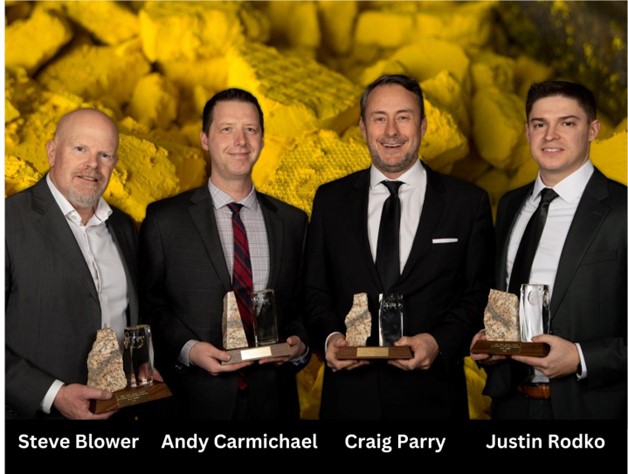
The IsoEnergy team are all working now – in different capacities - for a brand-new uranium company called Cosa Resources (COSA.V), led by Keith Bodnarchuk, another experienced uranium geologist and former IsoEnergy team member who had joined the group on the back of the Hurricane discovery to lead corporate development. Cosa has a portfolio comprising roughly 209,000 hectares across multiple projects in the Athabasca Basin region.
Steve Blower (Cosa Chairman), Craig Parry (Cosa Strategic Advisor), Andy Carmichael (Cosa VP of Exploration) and Justin Rodko (Cosa Corporate Development Manager) believe that “all of the properties are underexplored, and the majority reside within or adjacent to established uranium corridors.”
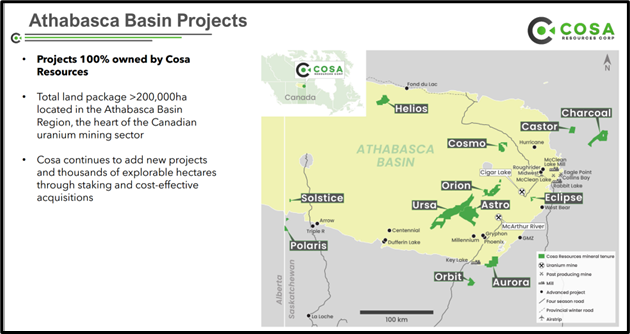
Cosa's primary focus through 2024 is initial drilling at the Ursa Project, which captures over 60-kilometres of strike length of the Cable Bay Shear Zone.
Modern geophysics completed by Cosa in 2023 identified multiple high-priority target areas characterized by conductive basement stratigraphy beneath or adjacent to broad zones of inferred sandstone alteration - a setting that is typical of most eastern Athabasca uranium deposits.
“The Cosa team is essentially the IsoEnergy team,” confirmed Mr. Blower. “Craig, Keith, Andy, Justin – heck we even have the original IsoEnergy CFO, Janine Richardson, on the Cosa board. We have reconstructed the DNA of ISO, and picked up some prime properties in the Athabasca Basin. We are going to deploy all our knowledge and techniques to find another significant uranium deposit.”
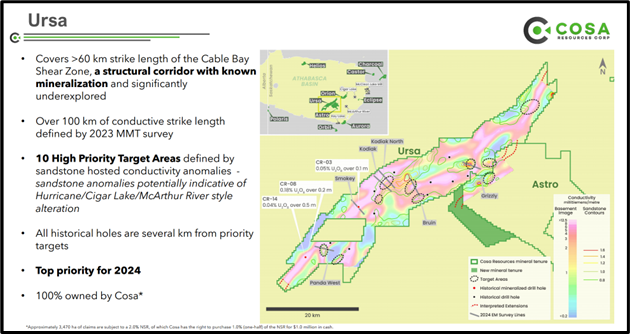
“Ursa is currently at the top of the priority list and that's where we are focusing first,” confirmed Cosa CEO Keith Bodnarchuk. “We've defined 10 key target areas through our work to date. The previous operators did good work, but were limited by the technology available at the time. We are applying modern exploration techniques to not only Ursa, but also to our growing pipeline of other exciting projects. Right now is an important milestone for Cosa as we have officially started our inaugural drill program at Ursa, testing the first of our interesting target areas.”
“In the last two decades, there have been six important discoveries in the Athabasca Basin,” continued Bodnarchuk. “And our group has been centrally involved in three of them. That doesn’t guarantee future success, but it’s a de-risking factor, and I believe it gives us a leg up on the competition.”
“Just as we did at Hurricane, we have found a lot of clues in the old data that inform our current thinking,” stated Carmichael “Collectively, we have designed what we believe is the best, most efficient way to drill the Ursa project.”
“The Hurricane team is back together,” confirmed Rodko. “We’re looking to do it again with Cosa Resources. We intend to spend money wisely. Of course, we want to make a discovery. Just like we did at Iso, we’ll continue to advance our best projects, chasing new opportunities as we identify them.”
On February 21,2024, Cosa announced the acquisition of the 100% owned Cosmo uranium property in the eastern Athabasca Basin.
Highlights:
- 12 contiguous mineral dispositions totalling over 9,300 hectares with no encumbrances acquired via low-cost staking.
- Cosmo captures 18 kilometres of prospective magnetic low strike-length with no prior drilling.
Mobilization for Cosa’s initial diamond drilling program at the Ursa Project is nearing completion.
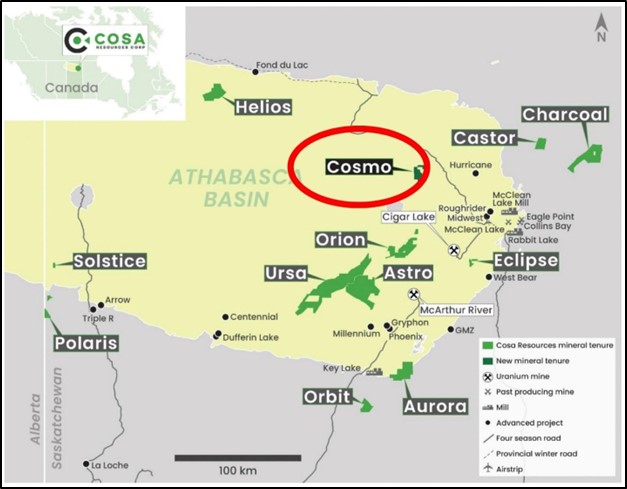
On March 4, 2024 Cosa announced that it has begun diamond drilling the Ursa Uranium Project.
Drill Program Highlights
- Up to 3,000 metres of drilling planned to evaluate the highly prospective Kodiak target area
- Interpretation of historical boulder geochemistry survey results identified large illite, uranium, and boron anomalies down-ice of the Kodiak target area
- Mobilization of additional fuel and supplies to facilitate a larger spring and summer drill program is underway
In 2024, from a capital markets’ point of view, what differentiates a uranium explorer from a gold, base metals or battery metals explorer, is that uranium explorers are getting favourably compensated for success with the drill bit.
The stock price for these uranium explorers will generally get an incremental bump for positive drill results. There are a lot of junior and mid-tier gold companies. The uranium sector is small by comparison. When capital flows into the sector it can be like trying to pour a gallon of water into a shot glass.
The project matters, and the team matters. The key factor for creating wealth in the capital markets - and mitigating risk - is people. Cosa has the best people in the uranium business. It’s as simple as that.
On the stage at the AME awards, Craig Parry gave a gracious speech, acknowledging the hard work and talent of the geological team that discovered the Hurricane Deposit.
Steve Blower, Andy Carmichael, and Justin Rodko were offered the microphone, but declined to speak.
“We had work to do,” explained Rodko, “discovering more uranium.”
Justin Hayek
Full Disclosure: The opinions I have expressed in this article should be considered biased. I have invested personally in Cosa, and PI Financial is part of a syndicate of underwriters raising money for the company. Before investing, consult with your investment advisor to discuss the risks and suitability.

